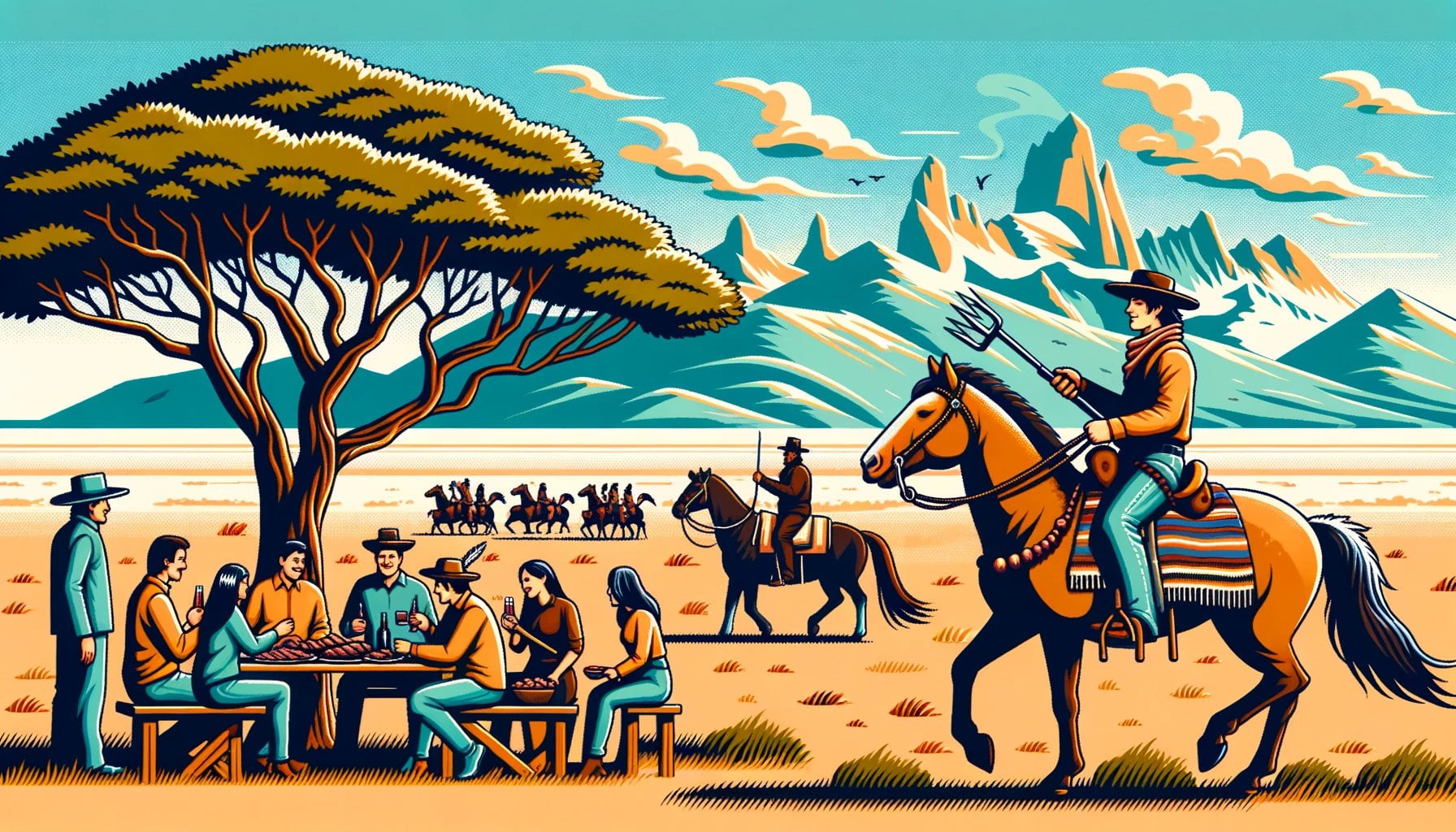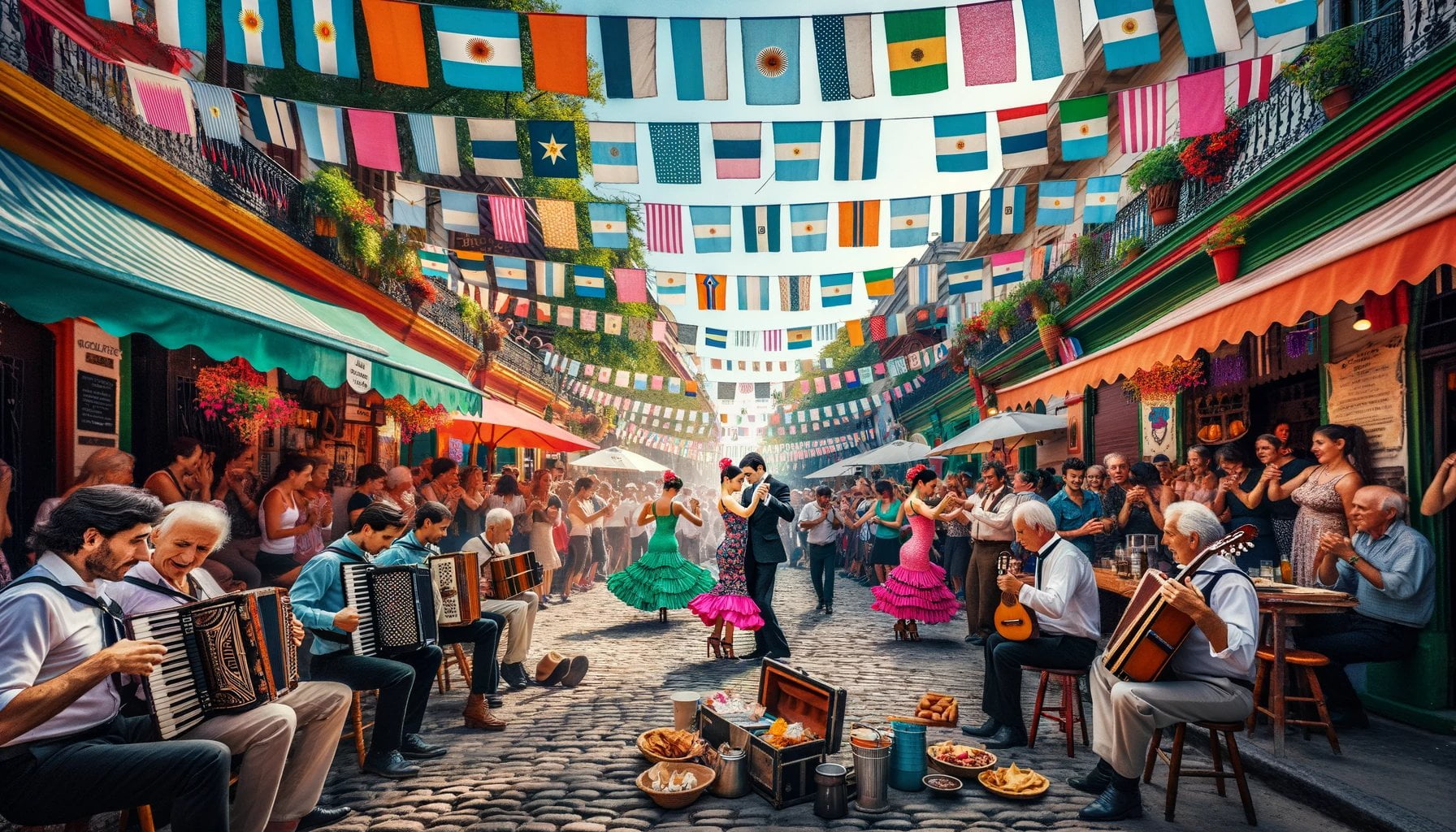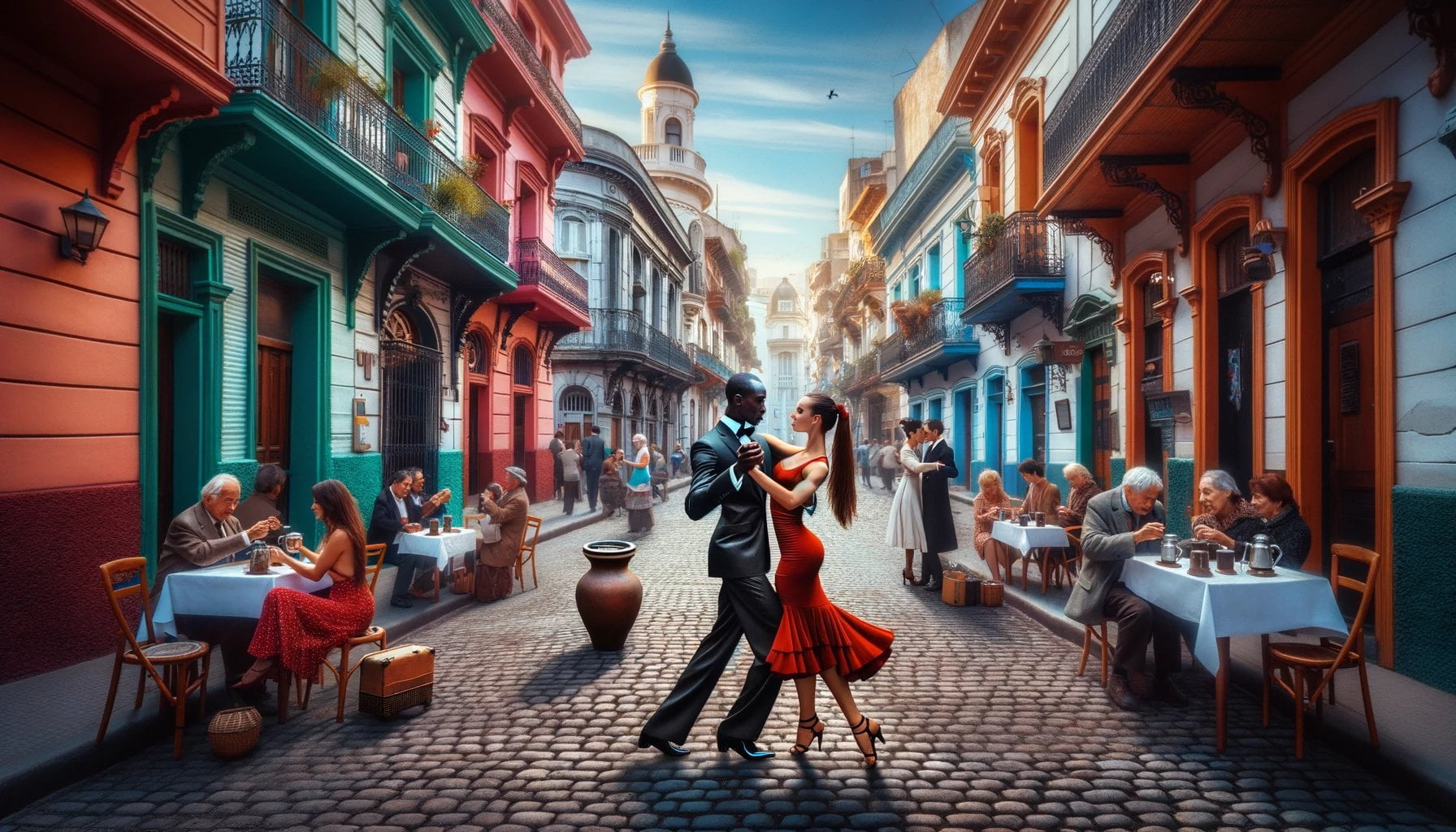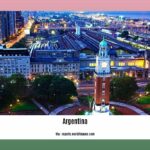Immerse yourself in the vibrant tapestry of tradition and expression that encapsulates Argentina’s rich and captivating culture. From the spirited rhythms of tango to the mouthwatering flavors of traditional cuisine, Argentina offers a wealth of experiences waiting to be discovered. Join us as we embark on a journey through the intricate nuances of Argentine traditions, exploring the country’s history, literature, music, dance, sports, and more. Through engaging storytelling and meticulous research, we aim to shed light on the multifaceted cultural landscape that makes Argentina truly unique.

Key Takeaways:
- Argentina’s culture is diverse and influenced by Spanish colonialism and European immigration.
- Spanish is the dominant language in Argentina, but there are at least 40 different languages spoken in the country, with the Rioplatense dialect being the most prevalent.
- Argentina has a rich literary history and a thriving publishing industry, with Argentine writers playing a significant role in Latin American literature.
- The country has a vibrant history of painting and sculpture, which dates back to before the development of modern Argentina in the 19th century.
- The Argentine film industry is active, producing around 170 full-length titles in 2012.
- Football (soccer) is the most popular sport in Argentina, while pato is the official national sport.
- Argentine cuisine offers a wide variety of dishes, including pasta, sausage, and desserts.
- Argentine values emphasize increasing social capital and fostering a shared national identity.
Argentina Culture
Argentina is a country known for its vibrant and diverse culture. Influenced by a mix of ethnic groups, including Spanish colonialism and European immigration, Argentina has developed a unique cultural tapestry that is rich in heritage and expression.
Language and Literature
The spoken languages in Argentina are incredibly diverse, with at least 40 different languages present. However, the dominant language is Spanish, with the most prevalent dialect being Rioplatense. This dialect, unique to Argentina and Uruguay, reflects the area’s history and cultural mix.
Argentina also boasts a rich literary history and an active publishing industry. Argentine writers have played a significant role in Latin American literature, producing renowned works that have resonated with audiences throughout the world.
Art and Creativity
The artistic expression in Argentina is vast and multifaceted. Argentine painters and sculptors have a rich history that dates back to before the development of modern Argentina in the 19th century. Their works showcase a diverse range of styles and influences, capturing the essence of Argentina’s cultural journey.
Film is another thriving aspect of Argentina’s cultural scene. The Argentine film industry is vibrant, with numerous full-length titles being created each year. These films explore a wide range of topics and genres, showcasing the creativity and storytelling prowess of Argentine filmmakers.
Sports and Cuisine
Sports hold a special place in Argentine culture, with football (soccer) being the most popular sport in the country. The passion and fervor that surround Argentine football are unmatched, making it an integral part of the national identity. Furthermore, the official national sport of Argentina is pato, a traditional game that combines elements of polo and basketball.
Argentine cuisine is a delightful fusion of flavors and influences. From delicious pastas to mouthwatering sausages and decadent desserts, Argentine cuisine offers a wide variety of dishes to tantalize the taste buds. Whether it’s indulging in a steak at a traditional parrilla or savoring the sweetness of dulce de leche, Argentina’s culinary landscape is sure to captivate any food lover.
Shared Identity and Values
Argentine values are centered around increasing social capital and fostering a shared identity core. The country’s diverse cultural heritage has been instrumental in shaping this sense of identity, with people from different backgrounds coming together to celebrate their collective roots. The vibrant cultural expressions serve as a reminder of the importance of embracing diversity and cherishing the values that unite us.
In conclusion, Argentina’s culture is a fascinating blend of traditions, expressions, and influences. From its diverse languages and literary contributions to its vibrant art scene and passionate sports culture, Argentina offers a tapestry of experiences that captivate and inspire. Through its cuisine, values, and shared identity, Argentina continues to leave a lasting impression on those who explore its cultural landscape.
Check out these interesting facts about Argentina, and learn more about this captivating country’s rich history, vibrant tourism industry, famous places, and delicious cuisine. Click here to explore fascinating facts about Argentina! Or, if you’re interested in delving into the enchanting world of tourism in Argentina, click here to discover the wonders that await you. Embark on a journey through Argentina’s captivating history by clicking here. For those seeking adventure, beauty, and awe-inspiring sights, don’t miss the chance to explore the famous places in Argentina by clicking here. And of course, don’t forget to tantalize your taste buds with the delectable flavors of Argentina’s cuisine by clicking here.
Literary Contributions and Famous Authors
Argentina has a rich and vibrant literary culture, showcasing the immense talent of its authors who have made significant contributions to the literary world. From thought-provoking novels to evocative poetry and captivating short stories, Argentine writers have left an indelible mark on the literary landscape. In this article, we will explore some of the most notable Argentine authors and their literary achievements.
1. Jorge Luis Borges
Jorge Luis Borges, born in Buenos Aires in 1899, was a versatile writer known for his profound exploration of complex philosophical themes. His short stories, essays, poetry, and translations blur the lines between reality and fiction, captivating readers with his unique storytelling style and thought-provoking narratives[^1^].
2. Adolfo Bioy Casares
Adolfo Bioy Casares gained acclaim for his fantastical novel “The Invention of Morel,” published in 1940. His skillful storytelling and ability to immerse readers in imaginative worlds have made him a beloved author among literature enthusiasts[^1^].
3. Julio Cortázar
Julio Cortázar is widely recognized for his contributions to the Latin American literary boom. His innovative narratives, experimental techniques, and exploration of non-linear storytelling have influenced readers and writers across continents[^1^].
4. Samantha Schweblin
Samantha Schweblin, a Spanish-language author born in Buenos Aires, has gained recognition for her compelling collections of short stories and her thought-provoking novel. Her captivating writing style and exploration of contemporary themes have positioned her as a rising star in Argentine literature[^1^].
5. Ernesto Sabato
Ernesto Sabato’s thought-provoking novels often delve into existentialism, the human condition, and political themes, resonating with readers around the world[^2^].
6. Silvina Ocampo
Silvina Ocampo’s unique perspective and exploration of fantasy and surrealism challenge societal norms, providing readers with a fresh and thought-provoking literary experience[^2^].
7. Flora Alejandra Pizarnik
Flora Alejandra Pizarnik’s raw and introspective poems delve into themes of identity, existence, and the human psyche, making her a celebrated and influential poet[^2^].
8. Alejandra Pizarnik
Alejandra Pizarnik’s powerful and evocative verses, exploring human emotions, continue to resonate with readers and receive critical acclaim[^3^].
9. Selva Almada
Selva Almada’s thought-provoking novels touch upon social issues and provide a voice for marginalized communities, making her an influential writer in Argentina[^3^].
10. Agustina Bazterrica
Agustina Bazterrica’s compelling novels explore dystopian themes and challenge societal norms, prompting readers to reflect on the human condition[^3^].
11. Claudia Piñeiro
Claudia Piñeiro’s gripping and socially relevant works shed light on pressing issues such as justice, inequality, and corruption, making her a prominent novelist and playwright in Argentina[^3^].
12. Leopoldo Lugones
Leopoldo Lugones, one of the pioneers of Argentine science fiction, inspired a new generation of writers to explore the realm of science fiction through his unique combination of preciosity and Symbolism[^4^].
13. Roberto Arlt
Roberto Arlt’s gritty depiction of urban life in Buenos Aires offers a unique insight into the realities of Argentine society, focusing on marginalized individuals and their struggles[^4^].
14. María Gainza
María Gainza’s blend of memoir and art criticism provides readers with a captivating exploration of art history and personal reflections, creating a rich and immersive reading experience[^3^].
15. Ricardo Piglia
Ricardo Piglia’s novels offer a deep insight into Argentine society and culture through their exploration of political and historical themes, establishing him as an influential writer and literary critic[^3^].
The literary contributions of Argentine authors have enriched the literary world with their unique storytelling techniques, exploration of social issues, and captivating narratives. From the renowned works of Jorge Luis Borges and Julio Cortázar to the rising stars like Selva Almada and Agustina Bazterrica, Argentina’s literary landscape continues to captivate readers around the globe.
Key Takeaways:
- Argentine literature boasts a wealth of talented authors who have made significant contributions to the literary world.
- The works of Argentine authors range from profound explorations of philosophical themes to imaginative storytelling and evocative poetry.
- Notable Argentine authors include Jorge Luis Borges, Julio Cortázar, Ernesto Sabato, Silvina Ocampo, Flora Alejandra Pizarnik, Alejandra Pizarnik, Selva Almada, Agustina Bazterrica, Claudia Piñeiro, Leopoldo Lugones, Roberto Arlt, María Gainza, and Ricardo Piglia.
- These authors have left an indelible mark on Argentine literature and continue to captivate readers with their thought-provoking narratives and exploration of social issues.
Sources:
Music and Dance Traditions in Argentina
Argentina is a country with a rich cultural heritage that embraces a wide array of traditions. A significant aspect of this vibrant culture is its music and dance traditions. From the iconic tango to energetic folkloric dances, Argentina offers a diverse range of musical and dance expressions that captivate both locals and visitors alike.
The Rhythmic Tapestry of Traditional Dances
Traditional dances in Argentina play a fundamental role in showcasing the country’s cultural expressions. These dances are celebrated in festivals and special events throughout the country, forming an integral part of the local culture.
One of the most renowned dances in Argentina is Tango. With its roots in the working-class neighborhoods of Buenos Aires, Tango has achieved global recognition for its passionate movements and evocative music. Tango serves as a powerful symbol of Argentine identity and is often performed in milongas (tango dance halls) where dancers showcase their skills and immerse themselves in the enchanting rhythms.
Apart from Tango, Argentina is home to several other traditional dances that reflect the diverse cultural influences within the country. Chacarera, originating from the northwest regions of Argentina, is known for its energetic movements and rhythmic music. This dance represents the rural traditions of the country and is performed in a lively and synchronized manner. Other dances such as carnavalito, zamba, and arunguita also contribute to the tapestry of Argentine dance traditions, each carrying its own unique characteristics and historical significance.
The Melodic Threads of Argentine Music
Argentina’s music landscape is equally diverse and captivating. Folkloric music holds a significant place in Argentine culture, influenced by indigenous, African, and colonial origins. It serves as a reflection of the country’s rich history and multifaceted identity.
In recent decades, the emergence of the Nueva Canción movement has added a contemporary twist to traditional Argentine folk music. This movement, popular during the 1960s and 1970s, infused traditional folk music with a rockier sound, creating a powerful blend of old and new. Nueva Canción artists used their music to express social and political messages, reflecting the changing times in Argentine society.
Argentina’s music scene extends beyond traditional genres, embracing an array of popular music styles. Genres such as rock, pop, cuarteto, and cumbia have evolved within the country, drawing influences from Spain, Latin America, Britain, and the United States. These genres contribute to the vibrant and dynamic music culture, attracting both local and international audiences.
Exploring the Cultural Tapestry
Argentina’s deep-rooted connection to music and dance traditions offers a gateway to its rich cultural tapestry. By engaging with these expressive artforms, one gains a deeper understanding of the country’s history, traditions, and identity.
Whether it’s the passionate embrace of Tango, the energetic movements of the Chacarera, or the melodic threads of Argentine folk music, music and dance traditions in Argentina serve as an invitation to explore and appreciate the country’s unique cultural heritage.
Key Takeaways:
- Argentina boasts a diverse range of traditional dances, with Tango being the most iconic and internationally recognized.
- The folkloric dances of Chacarera, carnavalito, zamba, and arunguita contribute to Argentina’s cultural landscape.
- Folkloric music plays a significant role in Argentine culture, reflecting indigenous, African, and colonial influences.
- The Nueva Canción movement brought a contemporary twist to traditional Argentine folk music in the 1960s and 1970s.
- Argentina’s popular music scene encompasses genres such as rock, pop, cuarteto, and cumbia.
- Engaging with Argentina’s music and dance traditions provides a deeper understanding of the country’s history, traditions, and identity.
Source:
– Culture Trip: 7 Traditional Argentinian Dances You Should Know
– What Argentina: Dance and Music in Argentina
Argentine Cuisine and Culinary Delights: Unveiling the Flavors of Tradition
Argentina’s vibrant culture is a tapestry woven from a multitude of influences, and its cuisine stands as a testament to this rich fusion. From the sizzling asado to the sweet indulgence of dulce de leche, Argentina’s culinary delights offer a tantalizing journey for the taste buds. Let’s dive into the flavors and traditions that make Argentine cuisine a true delight.
A Fusion of Flavors and Influences
Argentina’s cuisine is a reflection of its diverse history and the immigration waves that shaped the country. As people from various cultures settled in Argentina, they brought with them their culinary traditions, blending them with local ingredients to create unique and delectable dishes. From European influences like Italian and Spanish flavors to indigenous recipes, Argentine cuisine embraces a wide spectrum of tastes.
One iconic aspect of Argentine cuisine is the asado, a traditional barbecue that holds a special place in the hearts of Argentinians. The ritual of gathering around the grill, savoring succulent cuts of high-quality beef, is an essential part of the Argentine social fabric. It is a symbol of togetherness and celebration, where friends and family bond over the aromatic flavors and the art of grilling.
Traditional Delicacies From the Land of Gauchos
When exploring Argentine cuisine, it is impossible to overlook some of the country’s signature dishes. Empanadas, savory pastries filled with a variety of ingredients such as beef, cheese, or spinach, are a delicious on-the-go snack or a crowd-pleasing appetizer. The rich and smooth dulce de leche, a caramel-like spread made from condensed milk, is a staple in Argentine desserts, adding irresistible sweetness to everything it touches.
Choripan is another beloved street food, combining the smoky flavors of grilled sausage with the softness of fresh bread. The milanesa, a breaded and fried meat cutlet, showcases the Italian influence on Argentine cuisine, while provoleta, a melted provolone cheese dish, offers a mouthwatering combination of oozy cheese and smoky flavor.
For an authentic taste of Argentine culture, mate is a must-try. This infused tea, traditionally sipped from a hollowed-out gourd through a metal straw, is a symbol of friendship and hospitality. Sharing mate with friends and loved ones is an essential social ritual in Argentina, cementing bonds and fostering a sense of togetherness.
Regional Flavors and Culinary Diversity
Argentina’s vast geography gives rise to regional variations in dishes and flavors. Each province boasts its own culinary identity, showcasing unique local ingredients and cooking techniques. From the hearty locro stew simmering with corn, beans, and meats in the Andean Northwest to the delicate flavors of Patagonia’s lamb dishes, exploring the regional delights of Argentina is like embarking on a gastronomic adventure through the country’s diverse landscapes.
Key Takeaways:
- Argentine cuisine is a fusion of flavors and culinary traditions from various cultures around the world.
- The legendary asado, a traditional barbecue, is an essential social ritual in Argentina.
- Empanadas, dulce de leche, choripan, and milanesa are among Argentina’s beloved culinary delights.
- Sharing mate, a traditional infused tea, is a symbol of friendship and hospitality in Argentine culture.
- Argentina’s culinary landscape showcases regional variations, highlighting the country’s geographic and cultural diversity.
Citation:
– Sherpa Food Tours. “Ultimate Guide To Argentina’s Food Culture.”
– JTG Travel. “Argentina’s Food Culture: 9 Local Dishes to Try in Argentina.”

FAQ
Q1: What is the cultural heritage of Argentina?
A1: Argentina has a rich and diverse cultural heritage influenced by various ethnic groups, including Spanish colonialism and European immigration. The country’s culture is known for its vibrant music, dance, literature, and culinary traditions.
Q2: What are some traditional dances in Argentina?
A2: Some traditional dances in Argentina include tango, chacarera, carnavalito, zamba, and Arunguita. These dances are often celebrated in festivals and special events, showcasing the cultural richness of the country.
Q3: What is the significance of Tango in Argentine culture?
A3: Tango is one of the most iconic dances in Argentina and has gained international recognition. Originating in Buenos Aires in the late 19th century, tango quickly became a symbol of Argentine identity and is known for its passionate and seductive movements.
Q4: What is the role of literature in Argentine culture?
A4: Argentine literature has a rich history and has made significant contributions to the literary world. Argentine authors, such as Jorge Luis Borges and Julio Cortázar, have explored various genres and regional styles, captivating readers with their unique storytelling techniques and exploration of social issues.
Q5: What are some traditional dishes in Argentina?
A5: Some traditional dishes in Argentina include asado (barbecue), empanadas, dulce de leche (caramel sauce), choripan (sausage sandwich), milanesa (breaded meat cutlet), provoleta (grilled cheese), locro (stew), and mate (traditional herbal drink). These dishes reflect the country’s love for meat and fusion of flavors from different cultures.















